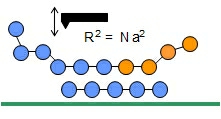ausgewählte Veröffentlichungen
- Kohn, P., Gharayan, L., Gupta, G., Sommer, M., Wicklein, A., Thelakkat, M., Thurn-Albrecht, T., Thermotropic Behavior, Packing, and Thin Film Structure of an Electron Accepting Side-Chain Polymer, Macromolecules 45, 5676-5683, (2012)

ABSTRACT: We report on the phase behavior and the structure of poly(perylene bisimide acrylate), an electron accepting semiconductor polymer with disclike side-chain units, in comparison to the corresponding low molecular weight perylene bisimide. By combination of DSC, optical microscopy, and temperature-dependent small-angle and wide-angle X-ray scattering, we show that both compounds display a lamello-columnar packing. While the perylene bisimide model compound crystallizes, the polymeric architecture of poly(perylene bisimide acrylate) suppresses order, leading to a 2D lamello-columnar liquid crystalline phase. The structure of the side-chain polymer in thin films with different thermal treatments as observed by GIWAXS correlates well with previously observed largely different electron mobilities. Such a polymeric, liquid crystalline compound combines the advantages of molecular order and easy processability, together with the film forming properties of polymeric materials.
- Henze, T., Schröter, K., Thurn-Albrecht, T., Investigation of the different stable states of the cantilever oscillation in an atomic force microscope, Nanotechnology 23, 245702 (2012)
ABSTRACT: We present an algorithm which allows us to identify all possible stable states of the cantilever oscillation of an AFM operated in the intermittent contact mode within the harmonic approximation. The oscillatory states are qualified as quasi-free, net-attractive and net-repulsive solutions. Using a generic model for the tip–sample interaction the influence of a number of important experimental parameters on the state of oscillation is systematically studied. The analysis gives conditions under which an AFM can be operated in a chosen state. As an exemplary experimental application we compare selected measurements on a semicrystalline polymer acquired in the net-repulsive and the net-attractive mode with simulations based on the approach introduced here. The experiments indicate that a small indentation below one nanometer in the net-attractive mode is enough to produce phase contrast.
-
Thermodynamic and Structural Changes in Ion-Containing
Symmetric Diblock Copolymers: A Small-Angle X-ray
Scattering Study, Macromolecules 45, 283−291 (2012)

ABSTRACT: We present temperature-dependent SAXS measurements on symmetric poly(styrene-block-2-vinylpyridine) and poly(styrene-block-ethylene oxide) with added lithium triflate. Salt doping led to a strong increase of the order−disorder transition temperatures and increased domain spacings. Based on a detailed analysis of the scattering data close to the order−disorder transition, three contributions to the structural changes can be distinguished: an increased incompatibility between the different monomers, the additional volume of the added salt, and chain stretching due to coordination between polymer and salt. At the phase transition, i.e. at constant interaction parameter χ, for low concentrations the increase in domain size is quantitatively explained by the volume of the added salt, and at higher concentrations chain stretching sets in. Structural and thermodynamic effects are considerably stronger in PEO than in P2VP.

Melt infiltration of microphase-separated block copolymers with a fluorinated block into nanoporous hard templates yields nanotubes with walls exhibiting mesoscopic fine structures such as concentric lamellae.
- Temperature and Molecular Weight Dependent Hierarchical Equilibrium Structures in Semiconducting Poly(3-hexylthiophene)Macromolecules, 2010, 43 (2010)

ABSTRACT: We report on structural investigations of a series of regioregular poly(3-hexylthiophene) with well-defined molecular weight (5-19 kg/mol) using DSC, small angle and wide-angle X-ray scattering, and AFM. With increasing temperature, we identify three ordered phases, namely 3D crystalline, 2D crystalline with disordered side chains, and a layered phase of smectic symmetry, followed by complete melting. Although all samples crystallize in extended chain conformation, the lower molecular weight material exhibits a lower crystallinity, most likely caused by noncrystallizable end groups. The crystallinity increases strongly with increasing molecular weight, which could be a possible explanation for the known dependence of charge transport properties on molecular weight.
- Interfacial Polarization and Field-Induced Orientation in Nanostructured Soft-Ion Conductors, Phys. Rev. Lett. 102, 216101 (2009)

ABSTRACT: We study the effects of interfacial polarization in and upon a self-assembled ion conductor based on a lamellar block copolymer and a lithium salt. Impedance spectroscopy combined with orientation experiments enable a quantitative analysis of ionic polarization and a direct demonstration of its aligning effect on the interfaces. The time constant of the ionic polarization is larger as expected from Maxwell-Wagner-Sillars theory and attributed to diffusion effects. The much stronger orientation effect of ionic vs dielectric polarization offers a new route to align (ion conducting) microdomains.





